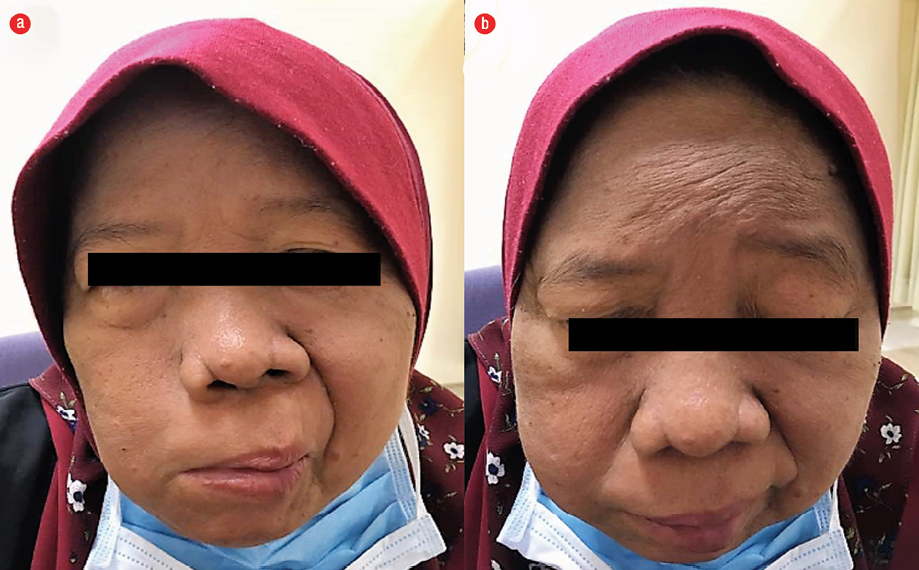A 69-year old woman who was on treatment for pulmonary tuberculosis presented with sudden onset of right-sided facial weakness [Figure 1] of 12 hours duration. This was associated with a three-week history of throbbing right ear pain. There was no hearing loss, tinnitus, vertigo, or headache. She was diagnosed with pulmonary tuberculosis 50 days ago, for which she was prescribed a daily regime of ethambutol, isoniazid, rifampicin, and pyrazinamide. She had hypertension but no ischemic heart disease or diabetes.
Her vitals showed a blood pressure of 116/60 mmHg and a pulse rate of 90 beats per minute. Her neurological examination revealed a loss of right-sided forehead creases, inability to close her right eye, right facial muscle weakness, leftward deviation of the angle of the mouth on smiling, and loss of the right nasolabial fold. Corneal reflexes showed slow eyelid closure on the right side. There was no slurring of speech or weakness of the muscles of the upper or lower limbs. There were no rashes, vesicles, or erythema noted on otoscopic examination.

Figure 1: (a) Patient looking forward while smiling. (b) Patient raising her eyebrows.
Question
- What is the most likely diagnosis?
a. Bell’s palsy.
b. Cortical stroke.
c. Lyme disease.
d. Parotid gland tumor.
e. Pontine stroke.
f. Ramsay Hunt syndrome.
Answer
a. Bell’s palsy.
A diagnosis of right Bell’s palsy was made with House-Brackmann grade 3 right facial nerve impairment. The patient was treated with oral prednisolone 30 mg b.d (twice daily) for one week with a tapering down dose over an additional two weeks. Acyclovir 800 mg five times a day for one week was also prescribed. The patient attended facial physiotherapy sessions.
Discussion
Bell’s palsy is a facial paralysis without rash. It is a unilateral peripheral facial nerve (VII) palsy or also known as a lower motor neuron disease. Bell’s palsy is usually a diagnosis of exclusion as 30–60% of the facial nerve palsy can be attributed to other factors.
Ramsay Hunt syndrome is a potential but unlikely diagnosis. Its presentation is usually accompanied by a vesicular rash in the affected ear/mouth. Other associated symptoms include tinnitus, hearing loss, nausea, vomiting, vertigo, and nystagmus, which were not present in this case. Isolated pontine stroke is rare, but is a great imitator of Bell’s palsy. It is commonly associated with a history of uncontrolled hypertension, hypertensive emergency, or neurological signs of stroke such as slurred speech. Cortical stroke is unlikely in this case as there is no sparing of the forehead muscle.1 Lyme disease of the cranial nerve can present like Bell’s palsy. However, it is usually accompanied by a travel history to an endemic area and the presence of a skin rash, arthralgia, and tick bite. If Lyme disease is suspected, confirmation can be done with positive serum analysis for the antibody to Borrelia burgdorferi.1 Parotid gland tumor can mimic Bell’s palsy; however, it has more insidious onset and systemic symptoms such as fever and chills as well as constitutional weight loss.1
Use of corticosteroid within 72 hours of symptom onset has been shown to reduce the sequelae complications such as incomplete recovery, autonomic dysfunction, and motor synkinesis.1 The beneficial effect of antivirals remains unclear. However, compared to no treatment, antiviral therapy is superior for partial recovery, but not for achieving complete recovery.2 The combination of antiviral and corticosteroid therapies have been shown to increase the chance of recovery, especially among those with severe symptoms.3 Corticosteroid given in this case would not have much effect on the reactivation of pulmonary tuberculosis as steroids are commonly used as an adjunct treatment in tuberculosis to prevent tuberculosis-related complications.4 Prognosis for Bell’s palsy is favorable. Without treatment, 70% will recover within six months. However, 30% will develop some degree of impairment related to facial muscle control, facial disfigurement, and psychological distress.5
Acknowledgements
We would like to thank the patient for her consent.
references
- 1. McCaul JA, Cascarini L, Godden D, Coombes D, Brennan PA, Kerawala CJ. Evidence based management of Bell’s palsy. Br J Oral Maxillofac Surg 2014 May;52(5):387-391.
- 2. Turgeon RD, Wilby KJ, Ensom MH. Antiviral treatment of Bell’s palsy based on baseline severity: a systematic review and meta-analysis. Am J Med 2015 Jun;128(6):617-628.
- 3. Lee HY, Byun JY, Park MS, Yeo SG. Steroid-antiviral treatment improves the recovery rate in patients with severe Bell’s palsy. Am J Med 2013 Apr;126(4):336-341.
- 4. Kadhiravan T, Deepanjali S. Role of corticosteroids in the treatment of tuberculosis: an evidence-based update. Indian J Chest Dis Allied Sci 2010 Jul-Sep;52(3):153-158.
- 5. Berg T, Bylund N, Marsk E, Jonsson L, Kanerva M, Hultcrantz M, et al. The effect of prednisolone on sequelae in Bell’s palsy. Arch Otolaryngol Head Neck Surg 2012 May;138(5):445-449.